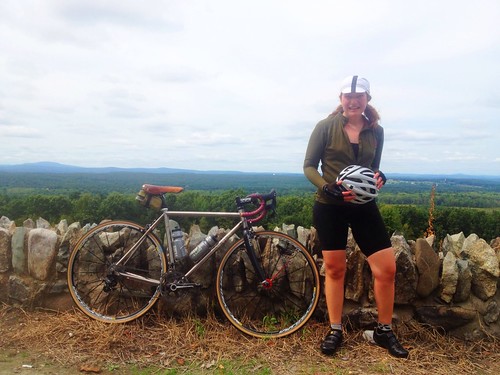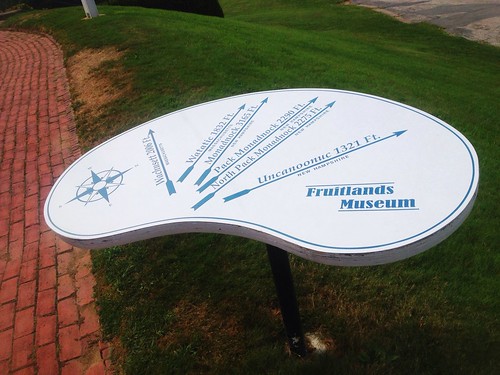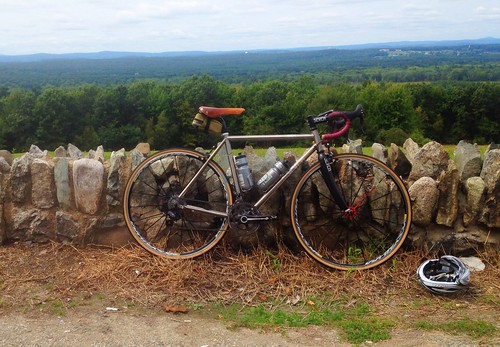 The Heavyweights
The HeavyweightsIn this category I place the traditional Dutch bikes: the classic models produced by Gazelle, Azor/Workcycles, Achielle, and Batavus. They have long, super-relaxed frames, high handlebars and 28" wheels. They are very heavy. They have heavy-duty racks and are designed to haul serious weight. They place the cyclist in a bolt-upright position. And their basic design has remained unaltered for nearly a century.
The benefit of the "heavyweights" is that they are supremely comfortable and stable. On a proper Dutch bicycle, you can expect to glide along even the most treacherous urban surfaces: You will not feel potholes, bumps, or cobblestones to nearly the same extent as you do on other bikes. You can load your rear or front rack with as much weight as you like without feeling the difference. You can give your friends rides on the rear rack while transporting your toddler on a handlebar-mounted childseat if you like - these bicycles were designed to handle that.
The drawbacks that come with these wonders are the weight (over 50lb - with the Workcycles/Azor being heavier than Gazelle and Batavus) and the wide turning radius. The weight of bicycles is not a problem for the Dutch, because they keep them parked outdoors. If you are not willing to do that and live in a 2nd floor apartment, consider whether you will be able to drag that much weight up and down the stairs every day. As for the handling, it is natural to expect that a long, relaxed bike will make fairly wide turns and will not want to weave aggressively though traffic. To some, this means that Dutch bikes are not sufficiently "maneuverable." Some also complain that because of their weight and relaxed position, it is difficult to cycle uphill on a Dutch bike - especially a prolonged hill.
Conclusion:These bicycles will give you unparalleled comfort and stability at the expense of weight and maneuverability.
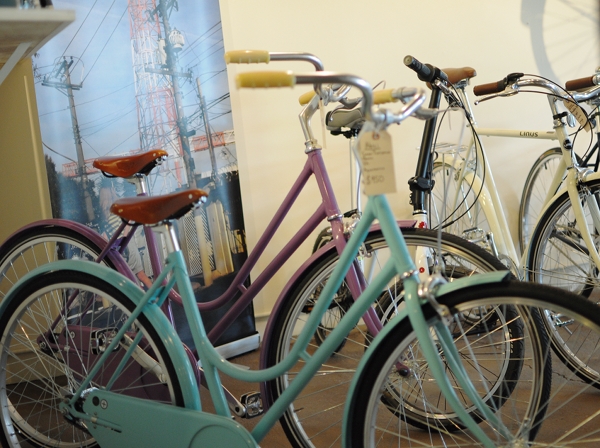 The Lightweights
The LightweightsAt the moment, the only loop frame bicycles in this category are the Italians:Abici and Bella Ciao. They are more nimble and sporty than their heftier cousins, with smaller frames and large-ish 700C wheels (a size typical of roadbikes).With their distinct curvature and clean lines, these bicycles are elegant, coltish and fast.
The benefit of the Italian lightweights, is that they are as light and zippy as you can possibly get on this type of city bicycle. Typical weight is 30-35 lb depending on gearing and lights. They do well on hills, they are easy to lift and carry, they are maneuverable.
On the downside, the ride quality is not quite as smooth as on the Dutch bikes. You will feel the road to a greater extent and you will not be as oblivious to the potholes and bumps. Because of their light weight and sportier geometry, these bicycles also have a limited load-carrying capacity. You can carry your bag and panniers, but you probably won't be able to wheel around your boyfriend and your toddler as you would on a Dutch bike. I am not even sure about the toddler alone.
Conclusion: These bicycles will give you lightweight speed and agility, at the expense of extra cushioning and hauling capacity.
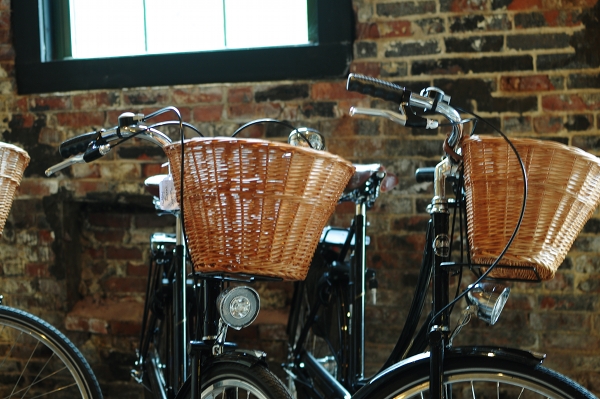 The Middleweights
The MiddleweightsAs you may have guessed, bicycles in this category are somewhere in between. They include the English Pashley, the Danish Velorbis, the Swedish Skeppshult and the German Retrovelo. Their frames are not as relaxed as the Dutch bicycles, but not as sporty as the Italians. They are typically fitted with 26" wheels. Sometimes these bicycles are specifically marketed as lighter-weight "improvements" compared to Dutch bikes or classic Roadsters.
I am going to combine the benefits and drawbacks of this category into one narrative, because they are not quite so clear-cut. In a very general sense, the benefit of these bicycles is that they are somewhat lighter than the Dutch bikes (40-45lb+), while also being somewhat sturdier than the Italian bikes. As for smoothness and cushiness of the ride, there is variability. I have found thePashley and the (non-balloon tire)Velorbis to be about the same in terms of cushioning as Bella Ciao, while also being nearly as heavy and just as difficult on uphills as some of the Dutch bikes. So in the case of these two, I do not feel as if the decrease in cushiness (in comparison to Dutch bikes) is adequately balanced by an equally significant decrease in weight. On the other hand, in the Retrovelo this problem seems to have been solved with theFat Frank balloon tires - the ride is almost as cushy as on a Dutch bike, with some of the weight shaved off and some maneuverability added. I have not tried the Velorbis balloon-tire bikes and cannot say how they compare. And I have not tried theSkeppshult at all.
Conclusion: Overall I am not sure what to make of these bicycles. Having ridden the Pashley, the Velorbis, and the Retrovelo, I would say that Retrovelo has the nicest ride quality of the three and Pashley the second nicest. But to me the bikes in this category do not feel that much lighter than Gazelle or Batavus.
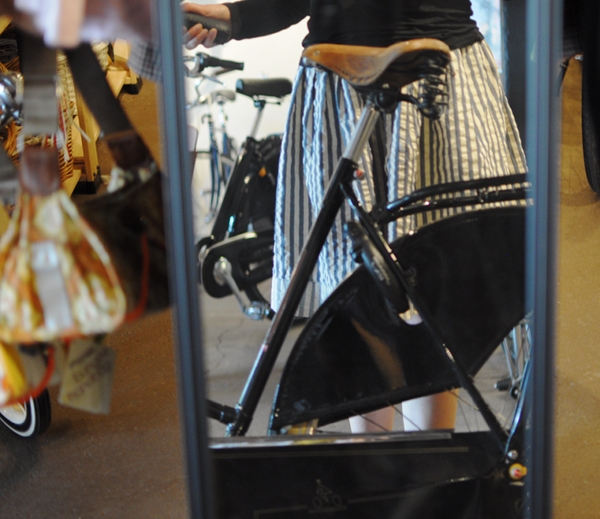 While this method of classification cannot begin to compete with the benefit of firsthand experience, I hope that it at least very generally suggests what to expect. The Dutch bicycles are obscenely comfortable, but cumbersome. The Italian bicycles are light and nimble, but do not offer the same sprawling sense of luxury. And the bicycles in between are a mixed bag. When considering which bicycle is right for you, the closest to "advice" I can give is to take very seriously your priorities and your limitations. It's not just about the weight and handling of the bicycle - but about what you need those factors to be like. We all need something different, and each of these bicycles is perfect for the right owner.
While this method of classification cannot begin to compete with the benefit of firsthand experience, I hope that it at least very generally suggests what to expect. The Dutch bicycles are obscenely comfortable, but cumbersome. The Italian bicycles are light and nimble, but do not offer the same sprawling sense of luxury. And the bicycles in between are a mixed bag. When considering which bicycle is right for you, the closest to "advice" I can give is to take very seriously your priorities and your limitations. It's not just about the weight and handling of the bicycle - but about what you need those factors to be like. We all need something different, and each of these bicycles is perfect for the right owner.




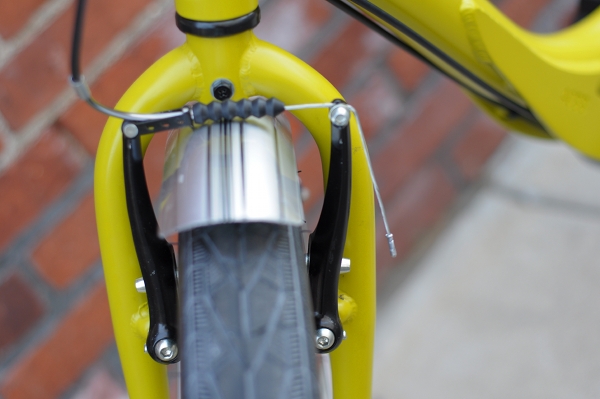 Those who have been reading this blog for some time, are no doubt familiar with my rants against unicrown forks. "The bike is nice... if it weren't for that unicrown fork," and so forth. When the topic comes up, some agree, others question my fixation on this detail, and others still want to know what a unicrown fork is. Now that I am temporarily living with a unicrown forked bike, the time seems right to elaborate.
Those who have been reading this blog for some time, are no doubt familiar with my rants against unicrown forks. "The bike is nice... if it weren't for that unicrown fork," and so forth. When the topic comes up, some agree, others question my fixation on this detail, and others still want to know what a unicrown fork is. Now that I am temporarily living with a unicrown forked bike, the time seems right to elaborate.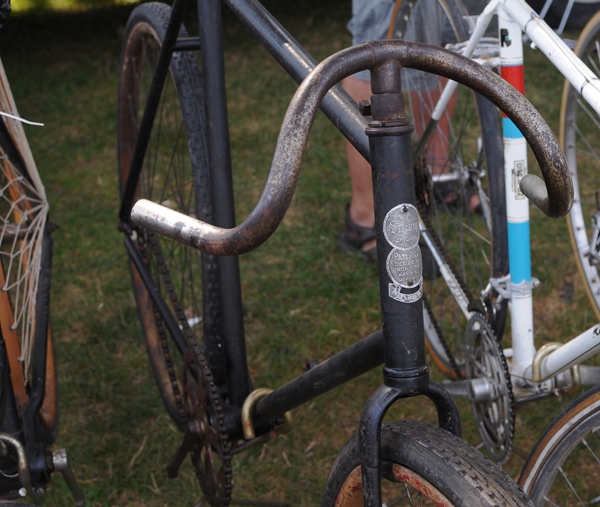 For some time now I've been trying to figure out the history of the unicrown fork, and I keep reading about the first mountain bikes, BMX bikes, and the quest for rigidity - suggesting that its origins were in the 1980s. But then I see antique bicycles- like this ancient Sterling pathracer at the Larz Anderson show last summer - which to me look like they are sporting hundred year old versions of unicrown forks. I have also seen what I can only describe as antique crownless flat-top forks - which appear to be similarly constructed, but are squared-off, rather than round. Would someone care to educate me on their history?
For some time now I've been trying to figure out the history of the unicrown fork, and I keep reading about the first mountain bikes, BMX bikes, and the quest for rigidity - suggesting that its origins were in the 1980s. But then I see antique bicycles- like this ancient Sterling pathracer at the Larz Anderson show last summer - which to me look like they are sporting hundred year old versions of unicrown forks. I have also seen what I can only describe as antique crownless flat-top forks - which appear to be similarly constructed, but are squared-off, rather than round. Would someone care to educate me on their history? The thing about unicrown forks, is that I don't actually dislike them per se, at least not in of themselves. What I dislike is when they are incongruent to the overall design of the bicycle. On a welded frame, a unicrown fork looks perfectly natural - integrating harmoniously with the bicycle frame. Just like I prefer lugged frames to welded frames, I similarly prefer lugged forks to unicrown forks. But objectively speaking, a unicrown fork looks fine on a welded frame - like on the D2R Boogie above.
The thing about unicrown forks, is that I don't actually dislike them per se, at least not in of themselves. What I dislike is when they are incongruent to the overall design of the bicycle. On a welded frame, a unicrown fork looks perfectly natural - integrating harmoniously with the bicycle frame. Just like I prefer lugged frames to welded frames, I similarly prefer lugged forks to unicrown forks. But objectively speaking, a unicrown fork looks fine on a welded frame - like on the D2R Boogie above. Unicrown fork on a welded DBC Swift, also looks appropriate. The frame joints and the unicrown fork match, and all are filed equally smoothly.
Unicrown fork on a welded DBC Swift, also looks appropriate. The frame joints and the unicrown fork match, and all are filed equally smoothly.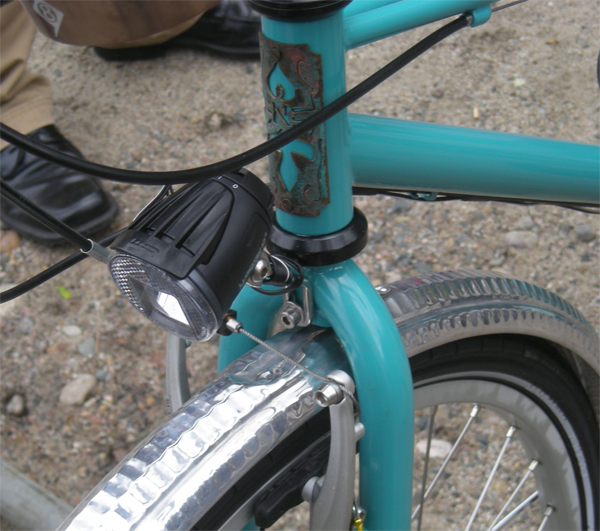 Unicrown fork on an ANT mixte. Now, if I were getting an ANT, I would opt for his segmented fork or his dual-plate crown fork - just because I prefer those styles and they are kind of his specialties. But I don't think there is anything inherently wrong with ANT using unicrown forks on TIG-welded bikes - again, the overall design is harmonious.
Unicrown fork on an ANT mixte. Now, if I were getting an ANT, I would opt for his segmented fork or his dual-plate crown fork - just because I prefer those styles and they are kind of his specialties. But I don't think there is anything inherently wrong with ANT using unicrown forks on TIG-welded bikes - again, the overall design is harmonious. The only time a unicrown fork actually bothers me, is when it is attached to a lugged frame - which is done quite frequently nowadays. Azor/Workcycles puts unicrown forks on their lugged frames, as do Batavus, Velorbis (balloon tire models only) and Abici (above), just to name a few. The reason is most likely a cost-cutting measure, undertaken perhaps with the hope that most customers simply won't notice. And it bothers me, not because I think that unicrown forks in themselves are "bad," but because I feel that a traditional lugged bicycle - especially when the manufacturer takes pride in describing it as such - calls for a traditional lugged fork. When the frame is lugged but the fork is not, the overall look of the bike comes across as disjointed to me; it doesn't "flow." It's only my opinion, but I think it's a fairly simple and logical notion as far as design goes.
The only time a unicrown fork actually bothers me, is when it is attached to a lugged frame - which is done quite frequently nowadays. Azor/Workcycles puts unicrown forks on their lugged frames, as do Batavus, Velorbis (balloon tire models only) and Abici (above), just to name a few. The reason is most likely a cost-cutting measure, undertaken perhaps with the hope that most customers simply won't notice. And it bothers me, not because I think that unicrown forks in themselves are "bad," but because I feel that a traditional lugged bicycle - especially when the manufacturer takes pride in describing it as such - calls for a traditional lugged fork. When the frame is lugged but the fork is not, the overall look of the bike comes across as disjointed to me; it doesn't "flow." It's only my opinion, but I think it's a fairly simple and logical notion as far as design goes. Here is the Co-Habitant's vintage Raleigh. I had to wear platform shoes, because I can't otherwise clear the top tube of his 24" bike.
Here is the Co-Habitant's vintage Raleigh. I had to wear platform shoes, because I can't otherwise clear the top tube of his 24" bike. And here is an
And here is an  I've tried leaning the bicycle over toward me until the frame is low enough to step over, but that does not seem right either. Ladies, how do you do it? And when you're wearing a skirt?
I've tried leaning the bicycle over toward me until the frame is low enough to step over, but that does not seem right either. Ladies, how do you do it? And when you're wearing a skirt?
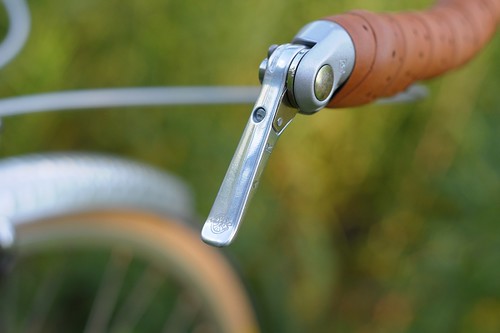
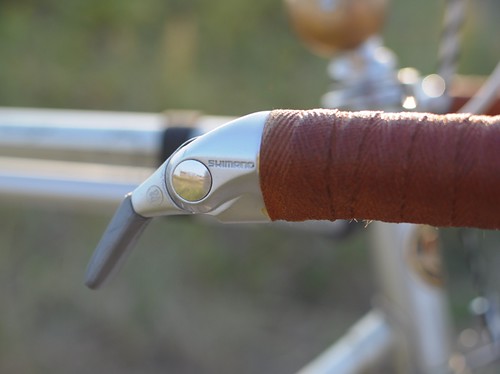
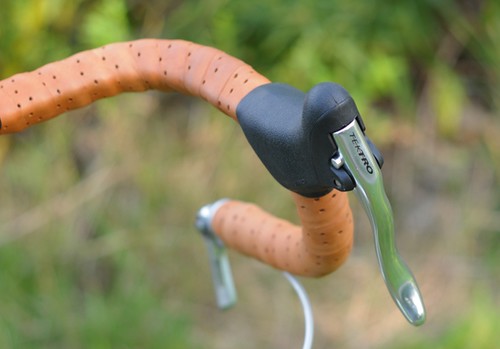







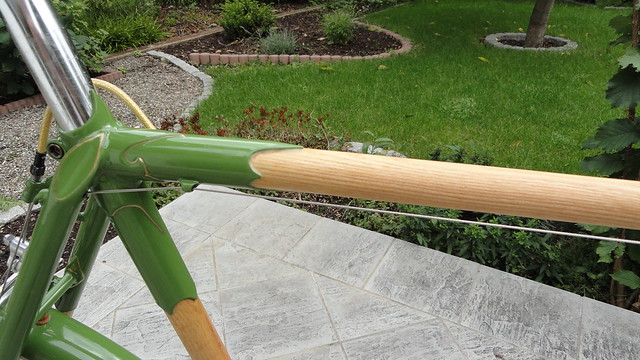
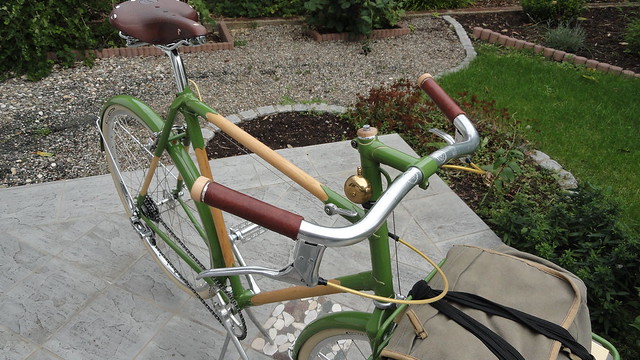


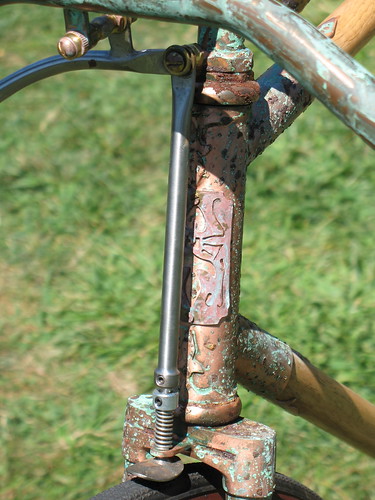

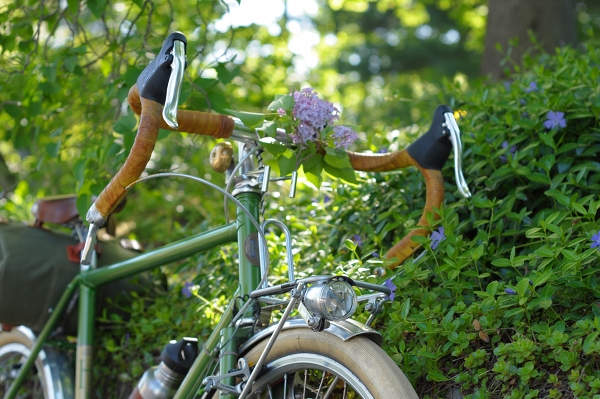 In describing my experience in a paceline training ride earlier, I had written that my Rivendellwas not the right bike for that ride. Subsequently, I've received some suggestions for how to make it faster - including getting narrower tires, installing "brifters," removing the saddlebag, rack and fenders, and stripping off the dynamo lighting. While I appreciate the advice and agree that all of that may indeed improve my paceline performance, I do not plan to make any changes to this bicycle. Right now, I have a bicycle that is perfectfor me as a touring bike. Why turn something that's perfect for one activity into something that's okay but not ideal for another?
In describing my experience in a paceline training ride earlier, I had written that my Rivendellwas not the right bike for that ride. Subsequently, I've received some suggestions for how to make it faster - including getting narrower tires, installing "brifters," removing the saddlebag, rack and fenders, and stripping off the dynamo lighting. While I appreciate the advice and agree that all of that may indeed improve my paceline performance, I do not plan to make any changes to this bicycle. Right now, I have a bicycle that is perfectfor me as a touring bike. Why turn something that's perfect for one activity into something that's okay but not ideal for another?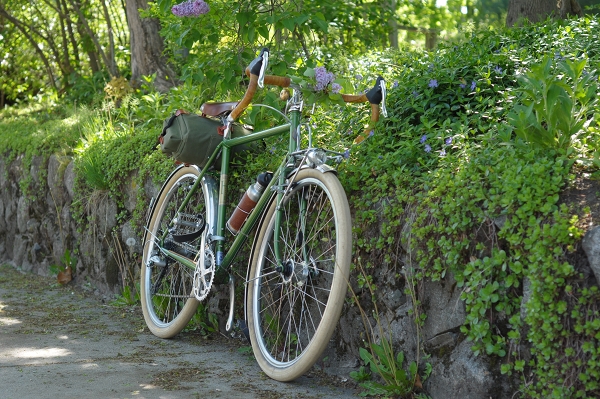 In stating that my Rivendell was not the right bike for a racing team-sponsored paceline ride, I was by no means criticising it or expressing unhappiness with it. I was merely reiterating a simple fact: Touring bikes are not racing bikes.
In stating that my Rivendell was not the right bike for a racing team-sponsored paceline ride, I was by no means criticising it or expressing unhappiness with it. I was merely reiterating a simple fact: Touring bikes are not racing bikes.  A touring bicycle is about exploration and about experiencing one's surroundings. You cannot do that when cycling 6" behind someone's rear wheel at 20mph.
A touring bicycle is about exploration and about experiencing one's surroundings. You cannot do that when cycling 6" behind someone's rear wheel at 20mph.  A touring bike is about the long haul and about going at one's own pace.I use the computer as a handlebar-mounted clock and odometer more than I use it as a speedometer - because "how far" is a more interesting question for this bike than "how fast."
A touring bike is about the long haul and about going at one's own pace.I use the computer as a handlebar-mounted clock and odometer more than I use it as a speedometer - because "how far" is a more interesting question for this bike than "how fast."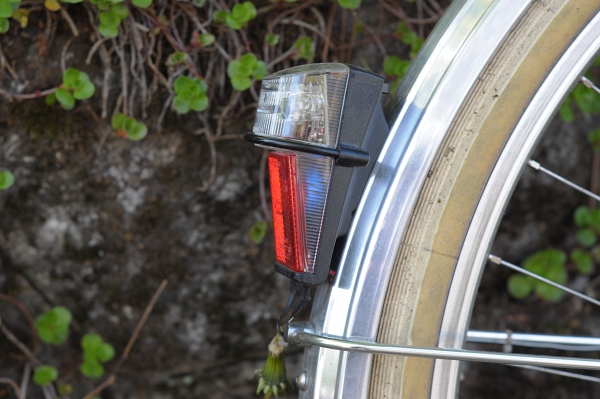 A touring bike is about the freedom of going anywhere, without having to cultivate the handling skills of a pro racer. Comfortable geometry and stable handling enable novice and experienced cyclists alike to ride. My bicycle is easy, and its wide, cushy tires make me immune to most of the fears that plague cyclists on modern roadbikes: potholes, rain, sand, uneven terrain - bring them on. I can even wear nice clothing while I'm at it, because the fenders will protect me from road grime. And with my bright, dynamo-generated lights I can cycle through the night and not worry about batteries.
A touring bike is about the freedom of going anywhere, without having to cultivate the handling skills of a pro racer. Comfortable geometry and stable handling enable novice and experienced cyclists alike to ride. My bicycle is easy, and its wide, cushy tires make me immune to most of the fears that plague cyclists on modern roadbikes: potholes, rain, sand, uneven terrain - bring them on. I can even wear nice clothing while I'm at it, because the fenders will protect me from road grime. And with my bright, dynamo-generated lights I can cycle through the night and not worry about batteries.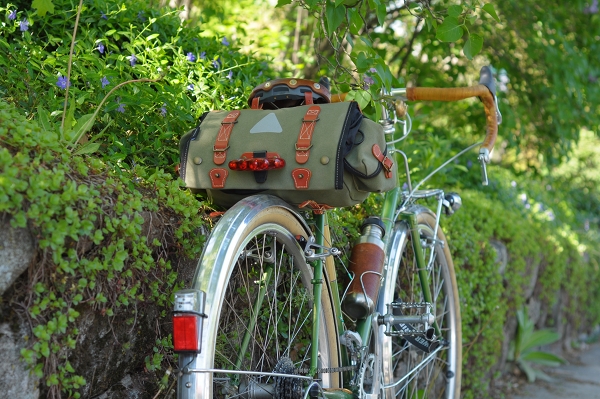 A touring bike is a home away from home. In my saddlebag, on the day this picture was taken I carried: a large DSLR camera, a sweater, a hat, an apple, a notebook, a fountain pen, a bar of chocolate, a saddle cover, gloves, sunscreen, a lock and a mini pump. And that's nothing compared to what I could have brought had I also attached my handlebar bag. Setting off on a racing bike limits you to a training ride and nothing more. On a touring bikea ride can start out as one thing and morph into another. Groceries can be involved, or a spontaneous visit to a friend's house. Who knows!
A touring bike is a home away from home. In my saddlebag, on the day this picture was taken I carried: a large DSLR camera, a sweater, a hat, an apple, a notebook, a fountain pen, a bar of chocolate, a saddle cover, gloves, sunscreen, a lock and a mini pump. And that's nothing compared to what I could have brought had I also attached my handlebar bag. Setting off on a racing bike limits you to a training ride and nothing more. On a touring bikea ride can start out as one thing and morph into another. Groceries can be involved, or a spontaneous visit to a friend's house. Who knows!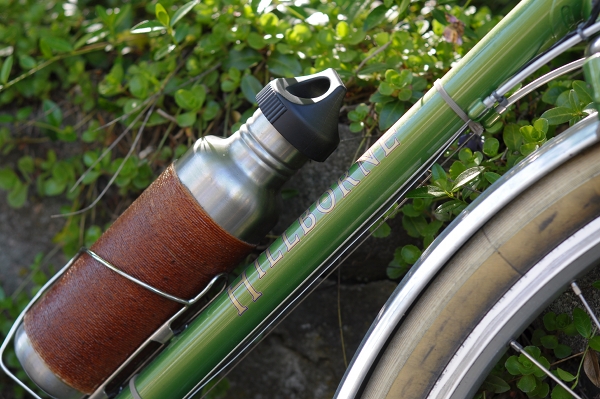 Riding a touring bike is an organic experience. My Rivendell'ssteel, brass, canvas, leather, twine, shellac and rubber fit harmoniously with its riding style and with my enjoyment of exploring nature. It is not about competing with nature with ever-more-efficient materials and aerodynamic postures, but about simply existing.
Riding a touring bike is an organic experience. My Rivendell'ssteel, brass, canvas, leather, twine, shellac and rubber fit harmoniously with its riding style and with my enjoyment of exploring nature. It is not about competing with nature with ever-more-efficient materials and aerodynamic postures, but about simply existing.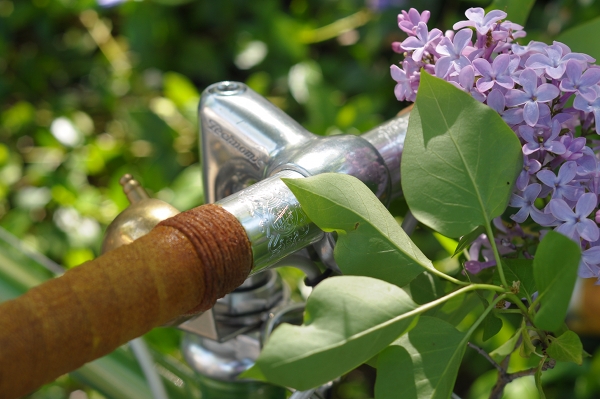 In turning this bicycleinto a performance-oriented bike, I would essentially be giving up the very things that make it special. And that would be a shame.
In turning this bicycleinto a performance-oriented bike, I would essentially be giving up the very things that make it special. And that would be a shame.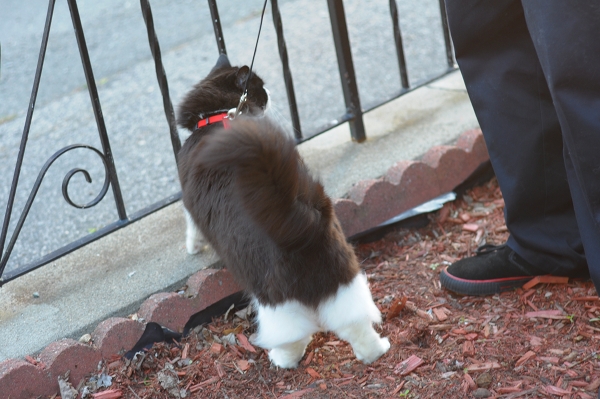 Sure, we may be curious about pacelines and racing.
Sure, we may be curious about pacelines and racing. But not at the expense of smelling the flowers. Some bicycles are perfect just the way they are.
But not at the expense of smelling the flowers. Some bicycles are perfect just the way they are.
